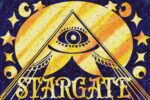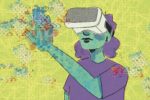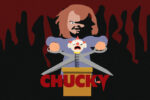Lesbians as a group are definitely not a monolith. But if you were to make a case for common trends among the group, you’d probably be met with little resistance if you talked about a common love of anything sci-fi, fantasy or horror.
This seems like a strange uniting passion, especially since all three genres are some of the most male-dominated forms of storytelling, but this detail is actually crucial to the cultural phenomenon that is lesbians’ appreciation of sci-fi, fantasy and horror. With most movies, books and general media, straight cisgender relationships take a key role, or men take key roles. For example, the romantic comedy in its most accepted form requires a man and woman to fall in love.
Meanwhile, comedy has historically been a genre where women are mocked or treated as sex objects so male leads can make male audiences laugh or sympathize with them, as seen in movies like “Zoolander” or “The 40-Year-Old Virgin.” Historical pieces often pretend that homosexuality and transgender identities were only created recently and will often overlook or write out homoerotic subtext — or even outright relationships — of characters inspired by real figures, like in “A Quiet Passion.”
Action movies may invite women on screen, though only in hypersexualized forms. These female characters are ultimately formatted to perfectly complement a male hero as they rely on physicality, something conventional society tells us that only men can possess. Even characters who are canonically queer like DC’s Harley Quinn and Diana Prince are pushed into heterosexual relationships. Sci-fi, fantasy and horror, however, are all formatted with either divergent gender roles or central female roles and writers or creators are often straight men.
This means that when women are present, they often stray away from conventional norms of femininity in favor of other gender identities, like identifying with being gender divergent or the archetypal “not like other girls” character. However, these less conventional gender identities are still depicted as desirable in works of sci-fi, fantasy and horror, which leaves them wide open to lesbian fans’ interpretations.
Probably the best and most prominent example of this occurs in the sci-fi horror classic “Alien,” where Sigourney Weaver stars as Ellen Ripley, a butch, strong, hot crew member of a spaceship that makes an emergency landing on an alien-infested planet. Because of Ripley’s complete lack of interaction with anyone besides the terrifying beings that are constantly trying to kill her, there are very few implications of her sexuality.
“Buffy the Vampire Slayer” is a horror show that brought lesbianism into the mainstream. Willow Rosenberg (played by Alyson Hannigan) is a part of the vampire hunting squad that the show focuses on. In later seasons, it is finally revealed that Willow is gay and, because of the enduring nature of “Buffy,” her queerness became a cult phenomenon. Her legacy is undercut by the “bury your gays” trope, which was employed by Joss Whedon and highly critiqued by audiences, but that has not stopped fans from adoring Willow — she even has a sea slug named after her.
In horror, there’s also the final girl trope, which is something that often requires a strong woman who is not involved with male characters in any meaningful way. “Scream” addresses this by joking about the horror movie rule that all you have to do to survive is not have sex. Because of this, final girls often lend themselves to a lesbian audience. Ellen Ripley is one of the first examples of this, and the “Scream” quadrilogy’s Sidney Prescott follows in her footsteps.
Sidney is portrayed by Neve Campbell, who gained fame in “Wild Things” and “The Craft,” both of which feature her in roles with heavy queer subtext or fanbases. More recently, Deena Johnson, played by Kiana Madeira in the “Fear Street” trilogy, makes this sapphic trend explicit by being an explicitly lesbian final girl.
In the realm of fantasy, there’s the famous example of Xena, the main character from “Xena: Warrior Princess.” Xena gained a cult following of lesbians due to her style and strength as well as her homoerotic relationship with her female companion Gabrielle. In fact, we can partially thank this character for the popularity of Subarus among lesbians. When Subaru did a marketing study in the ‘90s, they discovered that lesbians were one of their main demographics, and instead of ignoring them, they began a targeted ad campaign.
Because of the less accepting times, they elected to signal that Subaru was the car for lesbians by hinting through small yet impactful flourishes, including ambiguous catchphrases and adding specialized license plates like the famous “XENA LVR.” These minor details allowed lesbians to understand that the brand welcomed them while avoiding the wrath of straight clientele.
Movies like the “Fear Street” trilogy and shows like “I Am Not Okay With This” may indicate that mainstream audiences are finally comfortable enough to honor the lesbian fanbases that often make or break these three genres. But, even if lesbians aren’t officially considered leads, it can be fun to go back to your favorite sci-fi, fantasy and horror media and try to read the characters with a queer lens, like many generations already have.
















